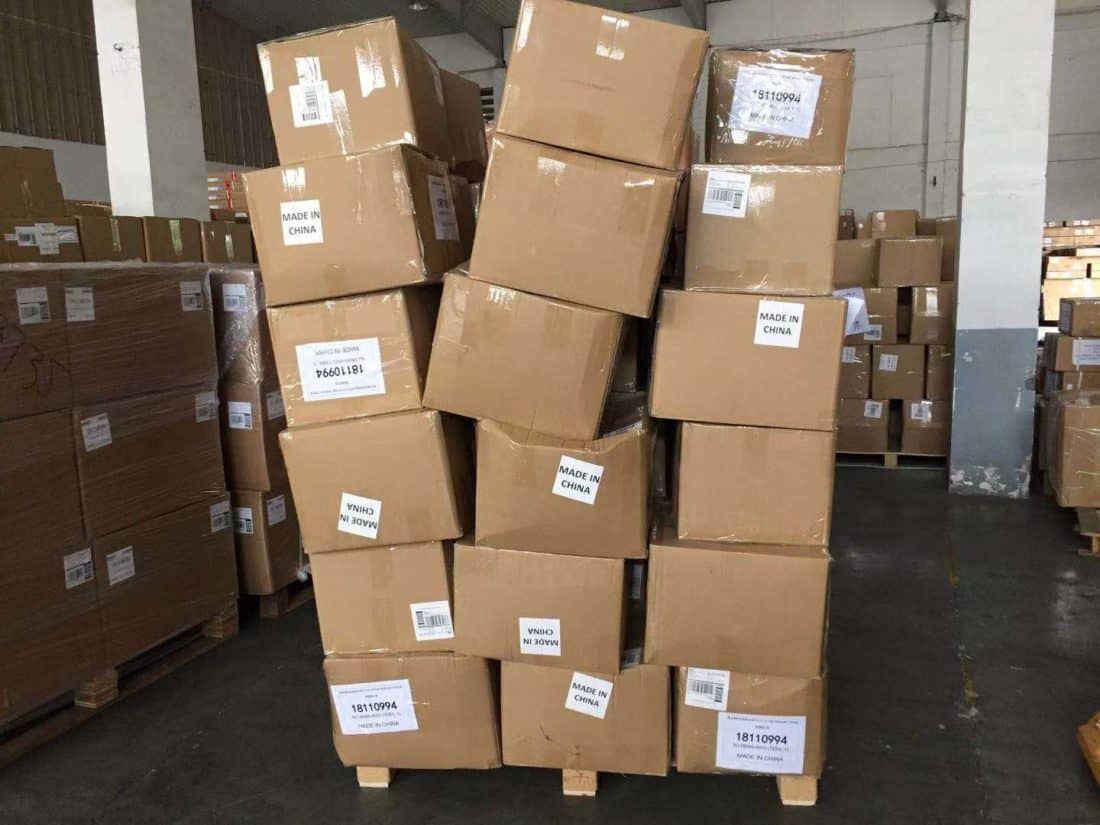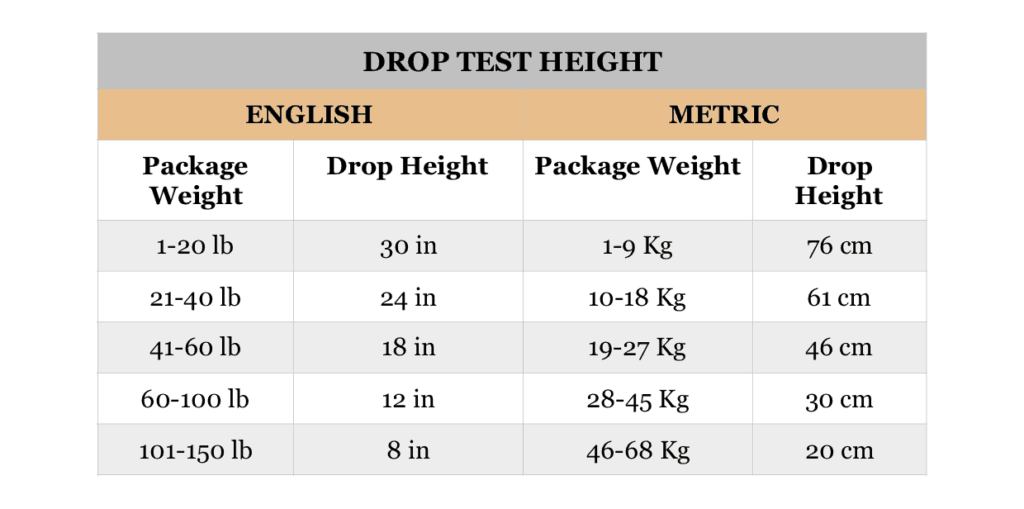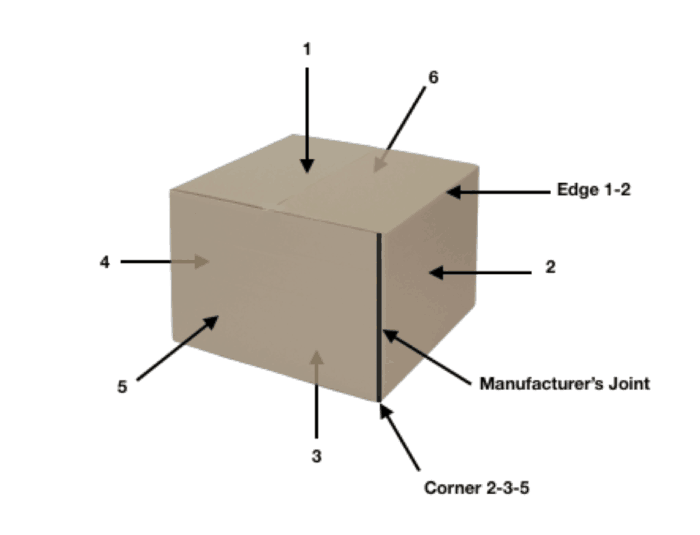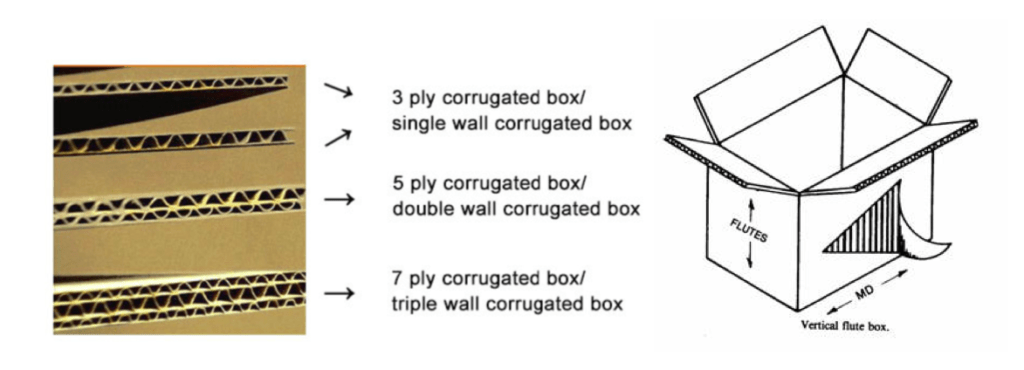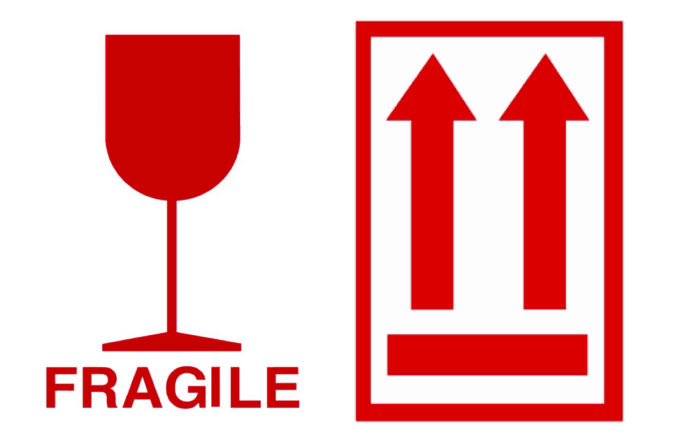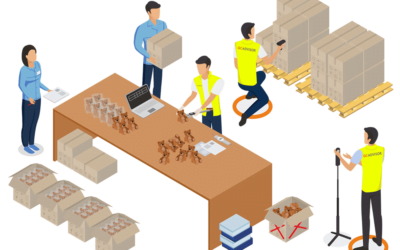You are about to find out.
First, let’s go further in detail in the drop test process.
This test is usually performed only on full master cartons. The main aim here is to determine how the packaging and goods inside will respond when hitting the ground.
Drop Test Standard & Procedure
The drop test is generally carried out in compliance with the ISTA (International Safe Transit Association) 1A standard, which applies to packaged products weighing 150 lb (68 kg) or less. The testing drop heights depend on the total weight of the product and package. The table below shows the corresponding drop heights and particular weight ranges.
The test is held by dropping the carton 10 times in total: first on a corner (the weakest or one expected to cause damage), then on one on each edge (with the shortest edge first), and after that on each face (the smallest face goes first). The carton should be dropped from the appropriate height and angle. It is important to twist the carton and drop it from all sides following the right order.
How to Evaluate the Results?
A carton FAILS the drop test if any of the following points are identified after the test:
- Significant damage to the shipping cartons;
- Significant damage to inner packaging;
- Deformation, scratches, dents or other damage to the products;
- Product functionality problems or safety risks with the product and its packaging resulting from the drop test.
What is considered as “significant damage” to cartons?
It means that all your products should be absolutely secured inside the carton after the test is performed. A carton PASSES if there’s mostly a regular deformation to the carton and no damage to the products inside.
The purpose and the procedure of the carton drop test look very clear, right?
But what if a carton FAILS the drop test during a Pre-Shipment Inspection? What can you do in this case?
Obviously? Nothing helps the situation here.
So, can we say that a carton drop test is useless during Pre-Shipment Inspection when all the products are packed into a Master Carton?
Obviously, yes.
What Are the Possible Ways to Qualify and verify Your Packing Properly?
1. Choose the right packing
Good quality packing is crucial to protecting your products during shipping. Product packing needs to be strong enough to move from A to B with the smallest damage. Typically, the price for replacing damaged goods is considerably higher than the price you pay for the appropriate protective packing. Accordingly, try to pick the proper packing to make sure your products will withstand a few thumps and bounces between being shipped and hitting the shelves.
A proper thickness and structural design do matter.
Provide the ideal condition for shipping your products by at least 5-ply corrugated (double wall) or even 7-ply (triple wall) cardboard, which guarantees a higher level of protection for the goods inside the carton where the weight is increased. Whenever possible, corrugated boxes should be designed with the corrugation direction vertical to the stacking surface when piled in their most stable orientation. Corrugated packaging is designed to provide the greatest amount of stacking strength when the corrugated flutes run in a vertical orientation. Cartons should be modelled in a way that enhances the stacking strength of corrugated flutes.
2. Keep track of the quantity and your products’ position inside the carton
Depending on the product type, too many items stacked together in one carton, arranged on top of each other, might cause damage. Therefore, it is important to determine the accurate number of items and their disposition in the inner/master carton.
Cartons should be neither too full nor too empty. To avoid products moving during transit, which can lead to both goods and the box being crushed, void space within the box must be filled (we advise a height of less than 5 cm inside).
You may use fillers to guarantee there are no gaps or movement inside the carton. When choosing void-filling materials, always ensure that they provide sufficient support for the weight of the shipment contents. Some materials might fall or collapse under the weight of the products, which may finally leave empty space inside the carton.
3. Add inner box & internal packaging materials
The inner box is a crucial part of any product packing. It’s an easy yet effective way to ensure that the products in the carton are kept safe. This solution offers double protection for the products. When using inner boxes put inside a master carton, it is preferable to choose cardboard that is strong enough to allow for normal handling in the warehouse. Inner boxes should not easily tear or break apart.
For protective internal packaging, bubble wrap, air bags, cardboard, corrugated dividers, and foam peanuts are all commonly used to protect products from damage. Each has various characteristics, and it is important to use them appropriately.
A combination of the above is needed to ensure sufficient protective and inner packaging is used to protect your products throughout the packing, shipping, storage, and retail stages.
4. Use additional measures
- “FRAGILE” labeling
Try to define the fragility of your product, label the cartons accordingly, and ensure any fragile product is marked as such before the shipment.
- Directional arrows
Some packing designs may require the product to remain in a specific orientation throughout shipment and storage. In this scenario, relevant directional arrows of the “This Side Up” marking must be used on both the master carton and the inner box.
The carton might be labelled with bi-directional arrows when it can be stacked in either direction pointed by the arrowheads but not perpendicularly to it.
Examples:
- Packing that cannot be safely stacked when placed flat or in the wrong orientation (e.g. Framed art);
- Cartons that must be piled with corrugated flutes located vertically to increase stack height.
Designs of some packaging may also require that the product remains in a precise location during shipment and storage. Here, you can use specific directional markings or “This Side Up” (unidirectional) arrows on the master carton and inner box.
5. Test your packing (before the whole packing is done!)
Yes, the drop test does make sense. However, an effective carton drop test must be done BEFORE you start packing your products. Only this way you can accurately evaluate whether your packing is strong enough for carrying your products a long way straight to the destination point. Also, it will allow you to take full control of the situation and improve the packing if the test FAILS. Hence, conducting a carton drop test before packing all of your goods allows you not only to ensure the strength of your packaging but also, if required, to change the situation without a significant loss of money and time.
To sum up, the above-mentioned points are the key to guaranteeing that your products are safe and sound on their way to the destination and ready to be sold and purchased immediately upon arrival.
And you, how do you qualify your product packing?
Learn more about our QC solutions and customized inspection checklist and protocols at www.qcadvisor.com

